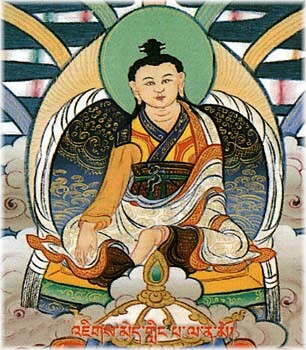Mind terma: Difference between revisions
Jump to navigation
Jump to search
mNo edit summary |
No edit summary |
||
| (One intermediate revision by one other user not shown) | |||
| Line 1: | Line 1: | ||
[[Image:Jikme Lingpa from 12 Dzogchen Teachers.jpg|frame|Rigdzin [[Jikmé Lingpa]], who revealed the [[Longchen Nyingtik]]]]'''Mind terma''' (Tib. དགོངས་གཏེར་, ''gong ter''; [[Wyl.]] ''dgongs gter'') — a category of [[terma]], discovered within the mindstream of the [[tertön]]. | [[Image:Jikme Lingpa from 12 Dzogchen Teachers.jpg|frame|Rigdzin [[Jikmé Lingpa]], who revealed the [[Longchen Nyingtik]]]]'''Mind terma''' (Tib. [[དགོངས་གཏེར་]], ''gong ter''; [[Wyl.]] ''dgongs gter'') — a category of [[terma]], discovered within the mindstream of the [[tertön]]. | ||
[[Dilgo Khyentse Rinpoche]] writes: | [[Dilgo Khyentse Rinpoche]] writes: | ||
| Line 20: | Line 20: | ||
[[Category:Termas]] | [[Category:Termas]] | ||
[[Category:Seven Authoritative Transmissions]] | |||
Latest revision as of 13:11, 14 February 2022

Mind terma (Tib. དགོངས་གཏེར་, gong ter; Wyl. dgongs gter) — a category of terma, discovered within the mindstream of the tertön.
Dilgo Khyentse Rinpoche writes:
- Mind treasures arise in the following way: In many instances, after bestowing an empowerment or giving a teaching, Padmasambhava made the prayer, "In the future, may this treasure arise in the mind of such and such tertön." While doing so, he would focus his prayers and blessings on the tertön, usually an incarnation of one of his disciples. When, due to Guru Rinpoche's blessings, the times comes, both the words and the meaning of the treasure arise clearly in the tertön's mind. The tertön can then write these down without having to think.[1]
Examples of gong ter are:
- the Seven Treasuries of Longchenpa,
- Mingyur Dorje’s Namchö,
- Jikme Lingpa’s Longchen Nyingtik and
- the termas of Kyabjé Dudjom Rinpoche.
Alternative Translations
- treasure of enlightened intent
Notes
- ↑ Dilgo Khyentse, Brilliant Moon (Boston & London: Shambhala, 2008), page 141.